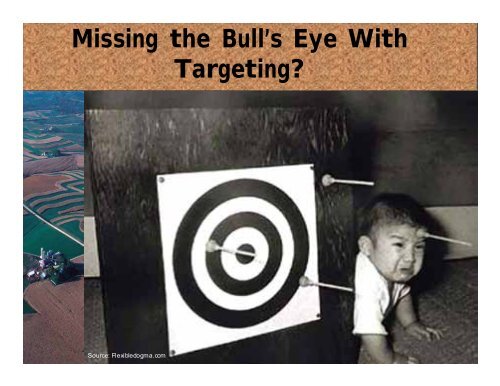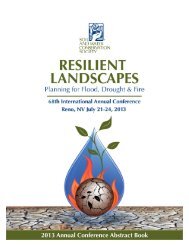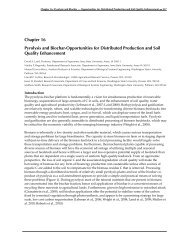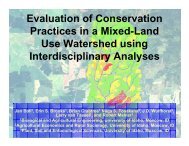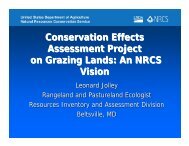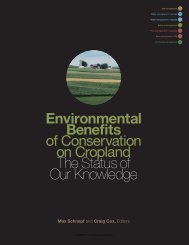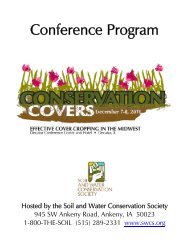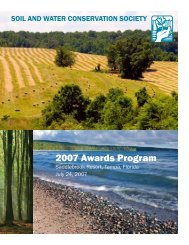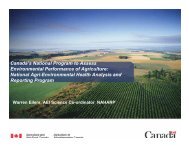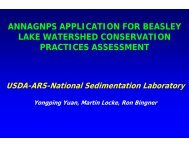Bentrup, Gary - Soil and Water Conservation Society
Bentrup, Gary - Soil and Water Conservation Society
Bentrup, Gary - Soil and Water Conservation Society
Create successful ePaper yourself
Turn your PDF publications into a flip-book with our unique Google optimized e-Paper software.
Missing the Bull’s Eye With<br />
Targeting?<br />
Source: Flexibledogma.com
Purpose of Targeting<br />
• Effective use of limited resources<br />
to focus preservation, conservation<br />
<strong>and</strong> other management alternatives<br />
to improve environmental quality<br />
Biophysical Foundation
Moving Data into Action<br />
ACCEPTANCE<br />
ADOPTION<br />
CULTURAL SUSTAINABILITY
Challenges
Challenges<br />
Urban/suburban l<strong>and</strong>s contribute<br />
more nitrogen (30 lb/ac/yr) than<br />
agricultural l<strong>and</strong>s (17 lb/ac/yr).<br />
Chesapeake Bay Foundation
Principles for Targeting Tools<br />
1. What, Where, How<br />
2. Biophysical, Economic, <strong>and</strong> Social<br />
3. User Participation<br />
4. Multiple Scales <strong>and</strong> L<strong>and</strong> Uses<br />
5. Loosely Coupled
1.What, Where, How<br />
Targeting Tools<br />
versus<br />
Research Tools
Research Tools<br />
Why?<br />
Source: www.icsu-scope.org/
Targeting Tools<br />
What, Where, <strong>and</strong> How?
2. Biophysical, Economic, Social
2. Biophysical, Economic, Social
2. Biophysical, Economic, Social
2. Biophysical, Economic, Social
3. User Participation
Tool Adoption Factors<br />
• Based on familiar data, procedures<br />
equations, etc.<br />
• Readily available data<br />
• Avoid the “black box”<br />
• Decision-support not decision-making
4. Multiple Scales-L<strong>and</strong> Uses<br />
Economic stability<br />
Stable banks<br />
<strong>Water</strong> quality<br />
Site<br />
Community<br />
<strong>Water</strong>shed<br />
Wildlife population<br />
Region
Surface Runoff Sediment<br />
Trapping Efficiency<br />
Percent Trapping Efficiency<br />
0-25.00<br />
0 125 250 500<br />
Kilometers<br />
25.01-50.00<br />
50.01-75.00<br />
75.01-100
Surface Runoff Sediment<br />
Trapping Efficiency<br />
Percent Trapping Efficiency<br />
75.01-100<br />
50.01-75.00<br />
25.01 - 50.00<br />
0-25.00<br />
<strong>Water</strong> Bodies<br />
<strong>Soil</strong>s Not Meeting Criteria<br />
0 50 100 200 Kilomet ers
Surface Runoff Sediment<br />
Trapping Efficiency<br />
Percent Trapping Efficiency<br />
75.01 - 100.00<br />
50.01 - 75.00<br />
25.01 - 50.00<br />
0 - 25.00<br />
<strong>Soil</strong>s not meeting criteria<br />
<strong>Water</strong> Bodies<br />
0 0. 5 1 2<br />
Kilometers
4. Multiple Scales-L<strong>and</strong> Uses<br />
Over 70% of the l<strong>and</strong> area<br />
is in agricultural production
5. Loosely Coupled<br />
Planning as a linear process<br />
1. 2. 3. 4. 5. 6.
5. Loosely Coupled<br />
Planning as an iterative process<br />
1. 2. 3. 4. 5. 6.
<strong>Conservation</strong> Buffer<br />
Planning Project
Soldier Creek<br />
<strong>Water</strong>shed<br />
Grassl<strong>and</strong>s/Herbaceous<br />
Pasture/Hay<br />
Row Crops<br />
Small Grain<br />
Fal low<br />
Low Intensity Residential<br />
High Intensity Residential<br />
Commercial/Industrial/Tran<br />
Deciduous Forest<br />
TOPEKA
Sediment Trapping<br />
Efficiency<br />
Percent Trapping Efficiency<br />
0 - 2 5 H<br />
2 5 -5 0 M H<br />
5 0 -7 5 M L<br />
7 5 -1 00 L<br />
N o t F a rm a b le<br />
W a te r<br />
5 0<br />
10<br />
miles
Decorative Willow Market Values<br />
Net Value - 1,000’<br />
Scarlet Curls Willow $3580<br />
Streamco Willow $1580<br />
French Pussy Willow $ 450<br />
Curly Willow $ 430<br />
(4-5’ foot plant spacing)
Decorative Willows<br />
Decorative Willow Suitability<br />
Highly Favor able<br />
Favorable<br />
5 0<br />
10<br />
miles
Wildlife Habitat & Movement<br />
Riparian Connectivity
Riparian Connectivity<br />
Rodger Barbour<br />
Mont St-Hilaire Nature Center<br />
#@%&*$@!!<br />
0.18 km<br />
Greg Sievert<br />
• 0.1 ha patches<br />
• Disperses 0.16 km<br />
<strong>Bentrup</strong> <strong>and</strong> Kellerman 2004
Riparian<br />
Connectivity<br />
Riparian Connectivity<br />
Ri parian Are as<br />
Co nn ectivity Zones<br />
Cr itical Gaps<br />
5 0<br />
10<br />
miles
Multiple<br />
Objectives<br />
Locations where plantings can:<br />
1. Protect <strong>and</strong> improve water quality<br />
2. Provide an alternative ag. product<br />
3. Restore riparian corridors for wildlife<br />
5 0<br />
10<br />
miles
Planning <strong>and</strong> Design Principles
<strong>Water</strong> Quality
Species & Habitat
Economic Opportunities
Visual Simulations
Benefits of 2-D Simulations<br />
• Promote better underst<strong>and</strong>ing<br />
• Increase involvement in planning<br />
• Create shared vision<br />
• Increase ownership<br />
• Increase adoption
Visual Simulation Starter Kit
Suite of Tools
Object Libraries
Visual Simulations
Assembling the Pieces<br />
Biological<br />
Considerations<br />
Social<br />
Considerations<br />
Questions?<br />
Economic<br />
Considerations<br />
Physical<br />
Considerations


